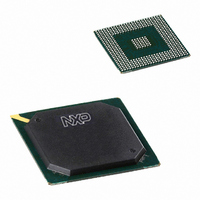PNX1501E,557 NXP Semiconductors, PNX1501E,557 Datasheet - Page 706

PNX1501E,557
Manufacturer Part Number
PNX1501E,557
Description
IC MEDIA PROC 266MHZ 456-BGA
Manufacturer
NXP Semiconductors
Datasheet
1.PNX1502EG557.pdf
(828 pages)
Specifications of PNX1501E,557
Applications
Multimedia
Core Processor
TriMedia
Controller Series
Nexperia
Interface
I²C, 2-Wire Serial
Number Of I /o
61
Voltage - Supply
1.14 V ~ 1.26 V
Operating Temperature
0°C ~ 85°C
Mounting Type
Surface Mount
Package / Case
456-BGA
Lead Free Status / RoHS Status
Lead free / RoHS Compliant
Program Memory Type
-
Ram Size
-
Other names
935274728557
PNX1501E
PNX1501E
PNX1501E
PNX1501E
Available stocks
Company
Part Number
Manufacturer
Quantity
Price
Company:
Part Number:
PNX1501E,557
Manufacturer:
NXP Semiconductors
Quantity:
10 000
- Current page: 706 of 828
- Download datasheet (8Mb)
Philips Semiconductors
Volume 1 of 1
PNX15XX_SER_3
Product data sheet
5.3 Initialization
After reset, the LAN100 software driver must initialize the LAN100 hardware. During
initialization the software must:
•
•
•
•
•
•
Depending on the PHY connected to the LAN100, the software must initialize
registers in the PHY via the MII Management Interface. The software can read and
write PHY registers by programming the MCFG, MCMD, and MADR registers of the
LAN100. Write data should be written to the MWTD register; read data and status
information can be read from the MRDD and MIND registers.
The LAN100 supports RMII and MII PHYs. During initialization, software must select
MII or RMII mode by programming the Command register. After initialization, the RMII
or MII mode should not be modified.
Transmit and receive DMA engines should be initialized by the device driver,
allocating the descriptor and status arrays in memory. Real-time transmit,
non-real-time transmit, and receive each have their own dedicated descriptor and
status arrays. The base addresses of these arrays must be programmed in the
TxDescriptor/TxStatus, TxRtDescriptor/TxRtStatus and RxDescriptor/RxStatus
registers. The number of descriptor structures in an array should match the number of
status structures.
Please note that the Transmit Descriptor Structures are 16 bytes each while the
Receive Descriptor Structures and status structures of both receive and transmit are
8 bytes each. All descriptor arrays must be aligned on 4-byte boundaries; status
arrays must be aligned on 16-byte boundaries. The number of descriptors in the
descriptor arrays must be written to the TxDescriptorNumber,
TxRtDescriptorNumber, and RxDescriptorNumber registers using a –1 encoding, that
is, the value in the registers is the number of descriptors minus one. For example, if
the descriptor array has 4 descriptors, the value of the number of descriptors register
should be 3.
After setting up the descriptor arrays, packet buffers must be allocated for the receive
descriptors before enabling the Receive Datapath. The Packet field of the receive
descriptors must be filled with the base address of the packet buffer of that descriptor.
Among others, the Control field in the receive descriptor must contain the size of the
data buffer using –1 encoding.
The Receive Datapath has a configurable filtering function for discarding or ignoring
specific Ethernet packets. The filtering function should also be configured during
initialization.
After a hard reset, the soft reset bit in the MII Interface will remain asserted. Before
enabling the LAN100, the soft reset condition must be removed.
Configure the PHY via the MII Management Interface (MIIM)
Select RMII or MII mode
Configure the transmit and receive DMA engines
Configure the host registers (MAC1,MAC2, etc.) in the MII Interface
Remove the soft reset condition from the MII Interface
Enable the receive and Transmit Datapaths
Rev. 3 — 17 March 2006
Chapter 23: LAN100 — Ethernet Media Access Controller
© Koninklijke Philips Electronics N.V. 2006. All rights reserved.
PNX15xx Series
23-37
Related parts for PNX1501E,557
Image
Part Number
Description
Manufacturer
Datasheet
Request
R
Part Number:
Description:
Manufacturer:
NXP Semiconductors
Datasheet:
Part Number:
Description:
Digital Signal Processors & Controllers (DSP, DSC) MEDIA PROCESSOR PNX15XX/266MHZ
Manufacturer:
NXP Semiconductors
Datasheet:

Part Number:
Description:
IC MEDIA PROC 266MHZ 456-BGA
Manufacturer:
NXP Semiconductors
Datasheet:
Part Number:
Description:
NXP Semiconductors designed the LPC2420/2460 microcontroller around a 16-bit/32-bitARM7TDMI-S CPU core with real-time debug interfaces that include both JTAG andembedded trace
Manufacturer:
NXP Semiconductors
Datasheet:

Part Number:
Description:
NXP Semiconductors designed the LPC2458 microcontroller around a 16-bit/32-bitARM7TDMI-S CPU core with real-time debug interfaces that include both JTAG andembedded trace
Manufacturer:
NXP Semiconductors
Datasheet:
Part Number:
Description:
NXP Semiconductors designed the LPC2468 microcontroller around a 16-bit/32-bitARM7TDMI-S CPU core with real-time debug interfaces that include both JTAG andembedded trace
Manufacturer:
NXP Semiconductors
Datasheet:
Part Number:
Description:
NXP Semiconductors designed the LPC2470 microcontroller, powered by theARM7TDMI-S core, to be a highly integrated microcontroller for a wide range ofapplications that require advanced communications and high quality graphic displays
Manufacturer:
NXP Semiconductors
Datasheet:
Part Number:
Description:
NXP Semiconductors designed the LPC2478 microcontroller, powered by theARM7TDMI-S core, to be a highly integrated microcontroller for a wide range ofapplications that require advanced communications and high quality graphic displays
Manufacturer:
NXP Semiconductors
Datasheet:
Part Number:
Description:
The Philips Semiconductors XA (eXtended Architecture) family of 16-bit single-chip microcontrollers is powerful enough to easily handle the requirements of high performance embedded applications, yet inexpensive enough to compete in the market for hi
Manufacturer:
NXP Semiconductors
Datasheet:

Part Number:
Description:
The Philips Semiconductors XA (eXtended Architecture) family of 16-bit single-chip microcontrollers is powerful enough to easily handle the requirements of high performance embedded applications, yet inexpensive enough to compete in the market for hi
Manufacturer:
NXP Semiconductors
Datasheet:
Part Number:
Description:
The XA-S3 device is a member of Philips Semiconductors? XA(eXtended Architecture) family of high performance 16-bitsingle-chip microcontrollers
Manufacturer:
NXP Semiconductors
Datasheet:

Part Number:
Description:
The NXP BlueStreak LH75401/LH75411 family consists of two low-cost 16/32-bit System-on-Chip (SoC) devices
Manufacturer:
NXP Semiconductors
Datasheet:

Part Number:
Description:
The NXP LPC3130/3131 combine an 180 MHz ARM926EJ-S CPU core, high-speed USB2
Manufacturer:
NXP Semiconductors
Datasheet:

Part Number:
Description:
The NXP LPC3141 combine a 270 MHz ARM926EJ-S CPU core, High-speed USB 2
Manufacturer:
NXP Semiconductors

Part Number:
Description:
The NXP LPC3143 combine a 270 MHz ARM926EJ-S CPU core, High-speed USB 2
Manufacturer:
NXP Semiconductors











